
Carpenter Gothic, also sometimes called Carpenter's Gothic or Rural Gothic, is a North American architectural style-designation for an application of Gothic Revival architectural detailing and picturesque massing applied to wooden structures built by house-carpenters. The abundance of North American timber and the carpenter-built vernacular architectures based upon it made a picturesque improvisation upon Gothic a natural evolution. Carpenter Gothic improvises upon features that were carved in stone in authentic Gothic architecture, whether original or in more scholarly revival styles; however, in the absence of the restraining influence of genuine Gothic structures, the style was freed to improvise and emphasize charm and quaintness rather than fidelity to received models. The genre received its impetus from the publication by Alexander Jackson Davis of Rural Residences and from detailed plans and elevations in publications by Andrew Jackson Downing.

The former Nast Trinity United Methodist Church, now known as The Warehouse Church, is a historic congregation of the United Methodist Church in Cincinnati, Ohio, United States. Designed by leading Cincinnati architect Samuel Hannaford and completed in 1880, it was the home of the first German Methodist church to be established anywhere in the world, and it was declared a historic site in the late twentieth century.

St. Mark's Episcopal Church is an historic Episcopal church located at 6-8 Highland Street in Ashland, New Hampshire, in the United States. Organized in 1855, it is part of the Episcopal Diocese of New Hampshire. Its building, completed in 1859, was designed by New York City architect J. Coleman Hart, and is one of the region's most distinctive churches, having a Gothic Revival design built out of half-timbered brick. On December 13, 1984, the church building was added to the National Register of Historic Places. The current pastor is Rev. Tobias Nyatsambo.
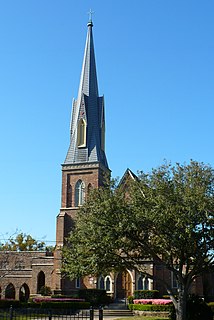
Trinity Episcopal Church is a historic church in Mobile, Alabama, United States. It was the first large Gothic Revival church built in Alabama. The building was designed by architects Frank Wills and Henry Dudley.
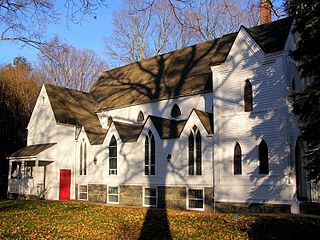
The Pine Meadow Historic District encompasses most of the historic 19th-century village of Pine Meadow in New Hartford, Connecticut. Located at a bend in the West Branch of the Farmington River southeast of New Hartford center, it is a well-preserved example of a rural industrial village. The district was listed on the National Register of Historic Places in 1996.
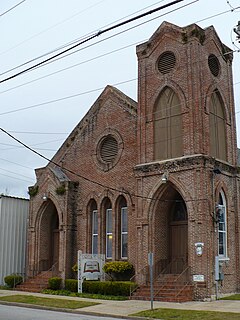
Emanuel African Methodist Episcopal Church is a historic African Methodist Episcopal Church congregation in Mobile, Alabama, United States. Emanuel AME began when church trustees purchased a vacant lot for their church in 1869, as African Americans in Mobile established their own congregations following the American Civil War. The trustees completed a frame building in that same year. The frame building was altered in 1881 when James F. Hutchisson, a locally prominent white architect, was hired to design a new facade. The existing building was faced in brick and the facade was redesigned in the Gothic Revival style. This made Emanuel AME Church comparable to white churches in the city and superior to both African American and white rural churches of the period. The building was added to the National Register of Historic Places on May 29, 1987, due to its architectural and historic significance.

Goshen Historic District is a historic district encompassing the town center village of Goshen, Connecticut. Centered at the junction of Connecticut Routes 4 and 63, the village developed historically as a rural crossroads of two turnpikes, and has retained its rural character. It is dominated by residential architecture from the first half of the 19th century, and includes churches, a store, and the town's former 1895 town hall. It was listed on the National Register of Historic Places in 1982.

Trinity Church is a historic church at 536 Milton Road in the Milton section of Litchfield, Connecticut. Built beginning in 1802, it is a distinctive blend of Gothic and Classical Revival architecture that is rare in rural Connecticut. The building was listed on the National Register of Historic Places in 1976.

The Union Church/St. Paul's Church is a historic church building at 3 Robertsville Road in the Riverton section of Barkhamsted, Connecticut. Built in 1829 to be shared by multiple congregations, it is an architecturally distinguished example of Greek Revival design with Gothic features. It became an Episcopal church in 1880 which closed in 1971, and served for a time as a local history museum. It now houses a glass-blowing studio. The building was listed on the National Register of Historic Places in 1985.

St. Thomas' Episcopal Church is located on Leedsville Road in Amenia Union, New York, United States. It is a mid-19th century brick church designed by Richard Upjohn in the Gothic Revival architectural style, built for a congregation organized shortly before.
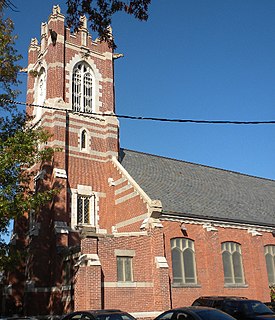
St. Luke's Episcopal Church is a historic church at 111-113 Whalley Avenue in New Haven, Connecticut. Built in 1905 for a congregation founded in 1844, it is a good example of late Gothic Revival architecture, and is further notable as the second church in the city established as an African-American congregation. It was listed on the National Register of Historic Places in 2003.

Trinity Episcopal Church is a historical Gothic Revival Episcopal church in Wheaton, Illinois.

Trinity Episcopal Church is a parish church in the Episcopal Diocese of Iowa. The church is located in Iowa City, Iowa, United States. It was listed on the National Register of Historic Places in 1974.

Marbledale or Marble Dale is a village in the town of Washington in Litchfield County, Connecticut. For U.S. Census purposes, it is included in the census-designated place of New Preston. Marbledale is part of the postal ZIP code 06777, officially known as New Preston Marble Dale.

Trinity Methodist Episcopal Church is a historic Methodist Episcopal church located at 185 Boulevard NE in Orangeburg, Orangeburg County, South Carolina. It was built between 1928 and 1944, and is a two-story, brick Late Gothic Revival-style church building on a raised basement. It features a large Tudor arched stained glass window with molded cast stone surround.

St. James Episcopal Church is a parish of the Diocese of Iowa located in Oskaloosa, Iowa, United States. It was listed on the National Register of Historic Places in 1991.

St. Andrew's Episcopal Church is located at North Main and Madison avenues in Albany, New York, United States. It is a complex of three buildings, centered on the church itself, a stone structure designed by architect Norman Sturgis in the Late Gothic Revival architectural style and built in 1930. In 2005 it was listed on the National Register of Historic Places.
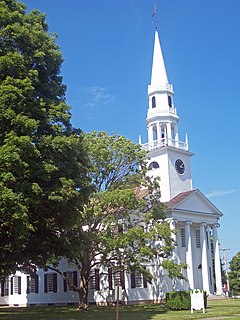
The First Congregational Church of Litchfield is a congregation of the United Church of Christ in Litchfield, Connecticut, USA, occupying a historic building on the Litchfield green.

St. Matthias Episcopal Church is a parish of the Episcopal Church located at Asheville, Buncombe County, North Carolina, in the Diocese of Western North Carolina. Founded in 1867, St. Matthias believes itself to be the oldest African-American congregation in the city.
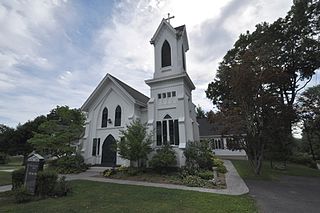
Bridgewater Center Historic District encompasses the traditional town center of Bridgewater, Connecticut. Centered at the junction of Main Street with Clapboard and Hat Shop Hill Roads, it developed in the early 19th century as a civic center, even before the town's 1856 incorporation from New Milford. The architecture of the center is largely reflective of the first half of the 19th century, including Greek Revival and Federal style buildings. It was listed on the National Register of Historic Places in 2000.























